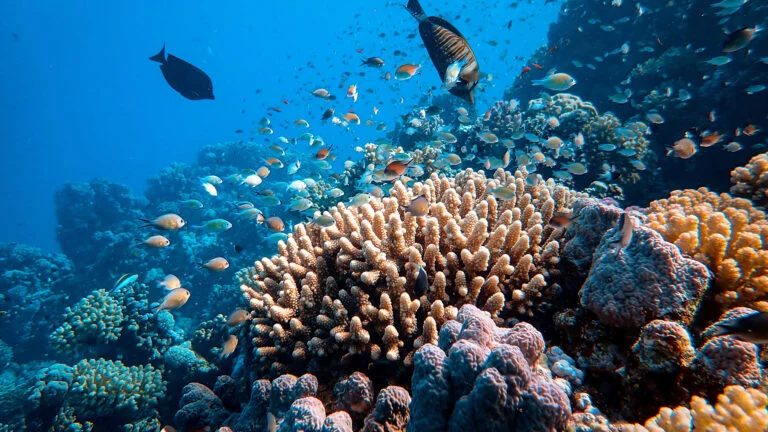Coral Bleaching & Marine Heatwaves
Coral reefs are vital marine ecosystems that support a vast range of marine biodiversity. However, coral bleaching and marine heatwaves (MHWs) have emerged as major threats due to climate change and anthropogenic stressors. Coral bleaching results from environmental stress that causes corals to expel their symbiotic zooxanthellae algae, leading to loss of color and weakening their ability to survive.
Coral Bleaching: Definition & Mechanism
What is Coral Bleaching?
Coral bleaching occurs when stressed corals expel the zooxanthellae algae living in their tissues, causing them to turn white (bleached). These algae provide corals with nutrients and oxygen through photosynthesis, and their absence makes corals highly vulnerable to disease and starvation.
Process of Coral Bleaching
- Normal Conditions: Corals and zooxanthellae share a mutualistic relationship where the algae provide food via photosynthesis, and in return, the corals offer protection.
- Stress Triggered: Due to elevated sea temperatures or other stressors, corals experience oxidative stress, leading to increased reactive oxygen species (ROS) inside coral tissues.
- Zooxanthellae Expulsion: To prevent cellular damage, corals expel their symbiotic algae, losing their major energy source.
- Bleached Coral: The coral skeleton becomes visible, making it appear white. If conditions do not improve, corals may die due to starvation or disease.
Key Technical Terms
- Zooxanthellae – Microscopic algae that live symbiotically within coral tissues.
- Photosynthesis – Process by which zooxanthellae convert sunlight into nutrients.
- Reactive Oxygen Species (ROS) – Harmful molecules produced due to environmental stress, causing cellular damage.
- Symbiotic Relationship – Mutual dependency between coral and algae.
Marine Heatwaves (MHWs) & Coral Bleaching
What are Marine Heatwaves?
Marine Heatwaves (MHWs) refer to prolonged periods of abnormally high sea surface temperatures (SSTs) that exceed a defined temperature threshold for a minimum of five consecutive days. MHWs significantly contribute to coral bleaching and mass mortality of marine organisms.
Causes of Marine Heatwaves
- Global Warming – Increase in greenhouse gases leads to rising ocean temperatures.
- El Niño-Southern Oscillation (ENSO) – A climate pattern causing warmer-than-average ocean temperatures in the Pacific.
- Weakening Ocean Currents – Reduced ocean circulation traps heat in surface layers.
- Atmospheric Blocking – Persistent high-pressure systems reduce cloud cover, increasing heat absorption by the ocean.
Classification of Marine Heatwaves (Hobday et al., 2018)
| Category | Intensity Above Average Temperature | Impact on Marine Life |
|---|---|---|
| Moderate | +1°C to +2°C | Minimal impact |
| Strong | +2°C to +3°C | Some coral bleaching |
| Severe | +3°C to +4°C | Widespread bleaching |
| Extreme | > +4°C | Mass mortality of corals |
Impact of Marine Heatwaves on Corals
- Longer bleaching events lead to higher coral mortality rates.
- Increased disease susceptibility due to weakened coral immune response.
- Disruption in coral reproduction and larval settlement.
- Decline in reef resilience and biodiversity loss.

Global Coral Bleaching Events & Case Studies
Major Global Mass Bleaching Events
- 1998 Event – Triggered by an extreme El Niño, causing 16% of the world's coral reefs to die.
- 2010 Event – Another El Niño event resulted in large-scale bleaching in Southeast Asia and the Caribbean.
- 2014-2017 Global Bleaching Event – The longest and most severe event, affecting 94% of the Great Barrier Reef.
- 2020 Indian Ocean Event – Indian Ocean reefs experienced severe bleaching due to rising SSTs.
Case Study: Great Barrier Reef (Australia)
- 2016 & 2017 Events: Consecutive bleaching episodes led to 50% loss of shallow-water corals.
- Cause: Rising SSTs due to climate change & El Niño.
- Impact: Collapse of fish populations dependent on coral reefs.
Causes of Coral Bleaching
Natural Causes
- Temperature Stress – Increased SSTs beyond the coral's thermal threshold (typically 1-2°C above normal).
- El Niño Effect – Warmer ocean conditions during ENSO cycles.
- Solar Radiation – Higher UV exposure damages coral tissues.
- Cyclones & Storms – Disrupt corals, reducing recovery ability.
Anthropogenic (Human-Induced) Causes
- Climate Change – Rising CO₂ emissions lead to ocean warming.
- Ocean Acidification – Excess CO₂ lowers pH, weakening coral skeletons.
- Coastal Pollution – Agricultural runoff (nitrates, phosphates) causes eutrophication.
- Overfishing – Disrupts the ecological balance of coral reef systems.
- Destructive Fishing Methods – Practices like blast fishing & cyanide fishing destroy reefs.
Consequences of Coral Bleaching
Ecological Impacts
- Loss of marine biodiversity (coral-dependent species).
- Reduction in fisheries productivity.
- Increased coastal erosion due to loss of reef protection.
Economic & Social Impacts
- Tourism Decline – Coral reefs contribute to a $36 billion tourism industry
- Livelihood Loss – Millions depend on reefs for food & employment.
- Displacement of Coastal Communities – Due to loss of fisheries & storm protection.
Coral Bleaching Mitigation & Conservation Efforts
Global Initiatives
- Paris Agreement (2015) – Limit warming below 1.5°C to protect coral reefs.
- UNESCO’s World Heritage Coral Reef Initiative – Focus on resilience-building efforts.
- Coral Reef Restoration Projects – Techniques like coral gardening, micro-fragmentation, & artificial reefs.
Indian Government Initiatives
- National Coral Reef Programme (NCRP) – Conservation & monitoring of India’s reefs.
- Coastal Regulation Zone (CRZ) Notification, 2011 – Protects coral ecosystems from coastal development.
- Integrated Coastal Zone Management (ICZM) – Promotes sustainable coastal management.
- Coral Transplantation in Gulf of Mannar – Successful transplantation efforts in Tamil Nadu.
Recent Developments in Coral Bleaching & Marine Heatwaves (2024–2025)
Coral bleaching and marine heatwaves (MHWs) have become more frequent and intense due to climate change, global warming, and rising sea surface temperatures (SSTs). The past two years (2023–2025) have witnessed record-breaking marine heatwaves, mass coral bleaching events, and significant economic losses, particularly in fisheries and tourism-dependent regions.
Alarming Rise in Marine Heatwaves (March 2025)
Key Findings:
- Marine heatwaves (MHWs) have increased in frequency, duration, and severity globally.
- 2024 saw the highest recorded ocean temperatures in history, leading to extreme stress on coral reefs.
- The intensity of heat stress is surpassing coral resilience, making it harder for reefs to recover.
- Even deep-water corals, previously thought to be less vulnerable, are now showing signs of bleaching.
Scientific Study Highlights:
- A recent Phys.org report (March 2025) indicates that global SSTs have been rising at an alarming rate, primarily due to anthropogenic climate change.
- The study links increased CO₂ emissions, weakened ocean currents, and altered wind patterns to the worsening MHWs.
Great Barrier Reef (GBR) Faces Another Mass Bleaching Event
Key Findings:
- The Great Barrier Reef (GBR) has suffered another large-scale bleaching event, similar in severity to the 2016–2017 mass bleaching incidents.
- Over 80% of surveyed reef sections show signs of bleaching, with some areas experiencing near-total coral mortality.
- High SSTs (above 30°C) have persisted for extended periods, worsening the bleaching crisis.
Implications for GBR:
- The reef's natural recovery processes are slowing down due to frequent bleaching events.
- Loss of key reef species is disrupting the entire marine food chain.
- Increased coral disease outbreaks have been observed post-bleaching.
Expert Warnings:
- The eos.org report (March 2025) suggests that without immediate climate action, the GBR could lose over 90% of its corals by 2050.
- Scientists emphasize the need for stronger marine conservation policies and global emission reductions.
Economic Losses Due to Marine Heatwaves (March 2025)
Key Findings:
- Marine heatwaves are causing billions of dollars in economic losses globally.
- The fisheries sector, coral-dependent tourism, and coastal economies are being heavily impacted.
- Coral reef-based tourism contributes over $36 billion annually worldwide, and severe bleaching is reducing tourist arrivals.
- Loss of fish stocks due to coral degradation is threatening food security and livelihoods in coastal communities.
Impact on Different Sectors:
| Sector | Impact |
|---|---|
| Fisheries | Reduced fish populations due to habitat destruction. |
| Tourism | Coral reef tourism declines as bleached reefs lose attractiveness. |
| Coastal Protection | Weakened coral structures increase coastal erosion and storm damage. |
| Local Communities | Economic hardships for millions of people reliant on reef-based industries. |
Record-Breaking Coral Damage in 2023–2024
Key Findings:
- 2023–2024 witnessed some of the most severe coral bleaching events ever recorded.
- Indian Ocean, Pacific, and Atlantic coral reefs suffered widespread bleaching and mass mortality.
- The frequency of bleaching events has accelerated, leaving little to no recovery time for affected reefs.
Regional Impacts:
| Region | Impact |
|---|---|
| Indian Ocean | Severe bleaching in Maldives, Lakshadweep, and Seychelles. |
| Pacific Ocean | Widespread coral loss in Australia, Indonesia, and Fiji. |
| Caribbean | Significant coral mortality recorded in the Bahamas and Belize. |
| Southeast Asia | Coral reefs near the Philippines and Thailand severely impacted. |
Expert Analysis:
- A report by Deccan Herald (2024) highlights that coral reefs in many regions are experiencing back-to-back bleaching with no time for natural recovery.
- Scientists warn that if global warming exceeds 2°C, more than 90% of coral reefs could be lost permanently.
Study: Entire Marine Ecosystems at Risk (March 2025)
Key Findings:
- A new study from The University of Western Australia (March 2025) warns that marine heatwaves are not only impacting corals but entire oceanic food chains.
- The destruction of coral reefs is leading to fish population crashes, affecting predator-prey relationships in marine ecosystems.
- Disruptions in plankton populations (the base of the food chain) could trigger a collapse of entire marine ecosystems.
Future Projections:
- If ocean warming continues, mass extinction events in marine biodiversity are likely.
- Urgent need for reducing greenhouse gas emissions and establishing Marine Protected Areas (MPAs).
Coral bleaching and marine heatwaves are critical threats to global marine biodiversity and coastal economies. Immediate climate action, sustainable coastal management, and global cooperation are essential to ensure the survival of coral reefs.













